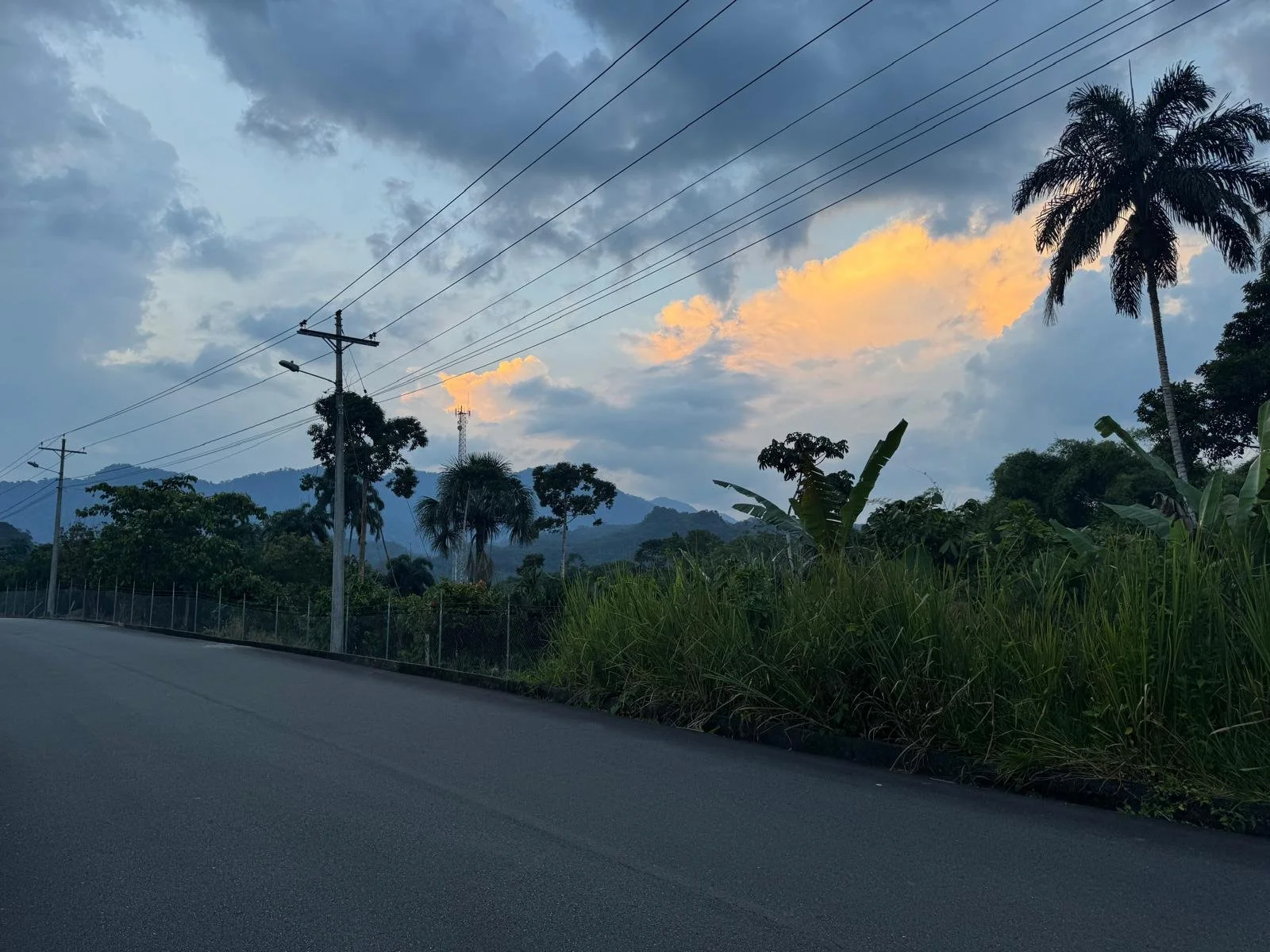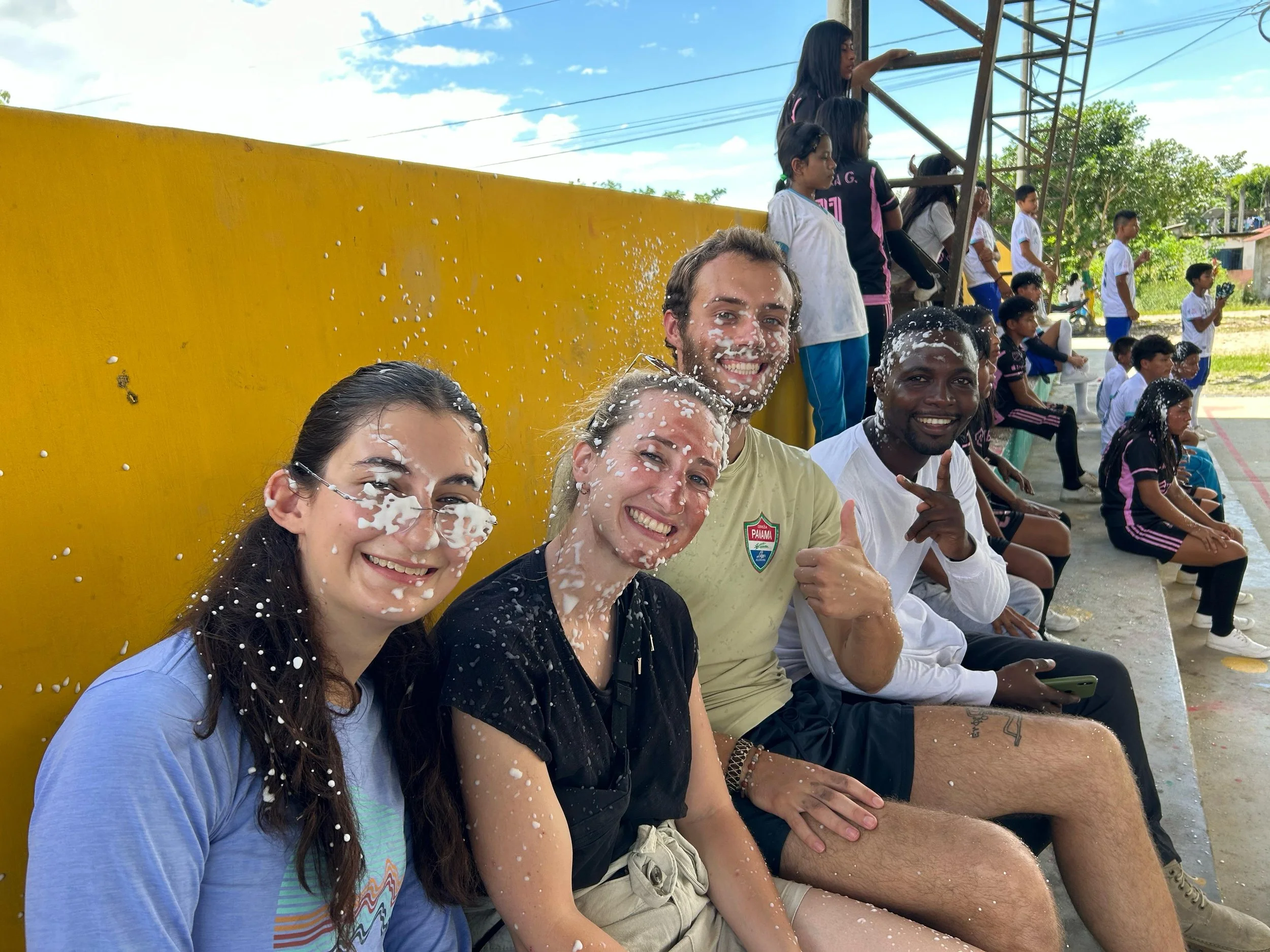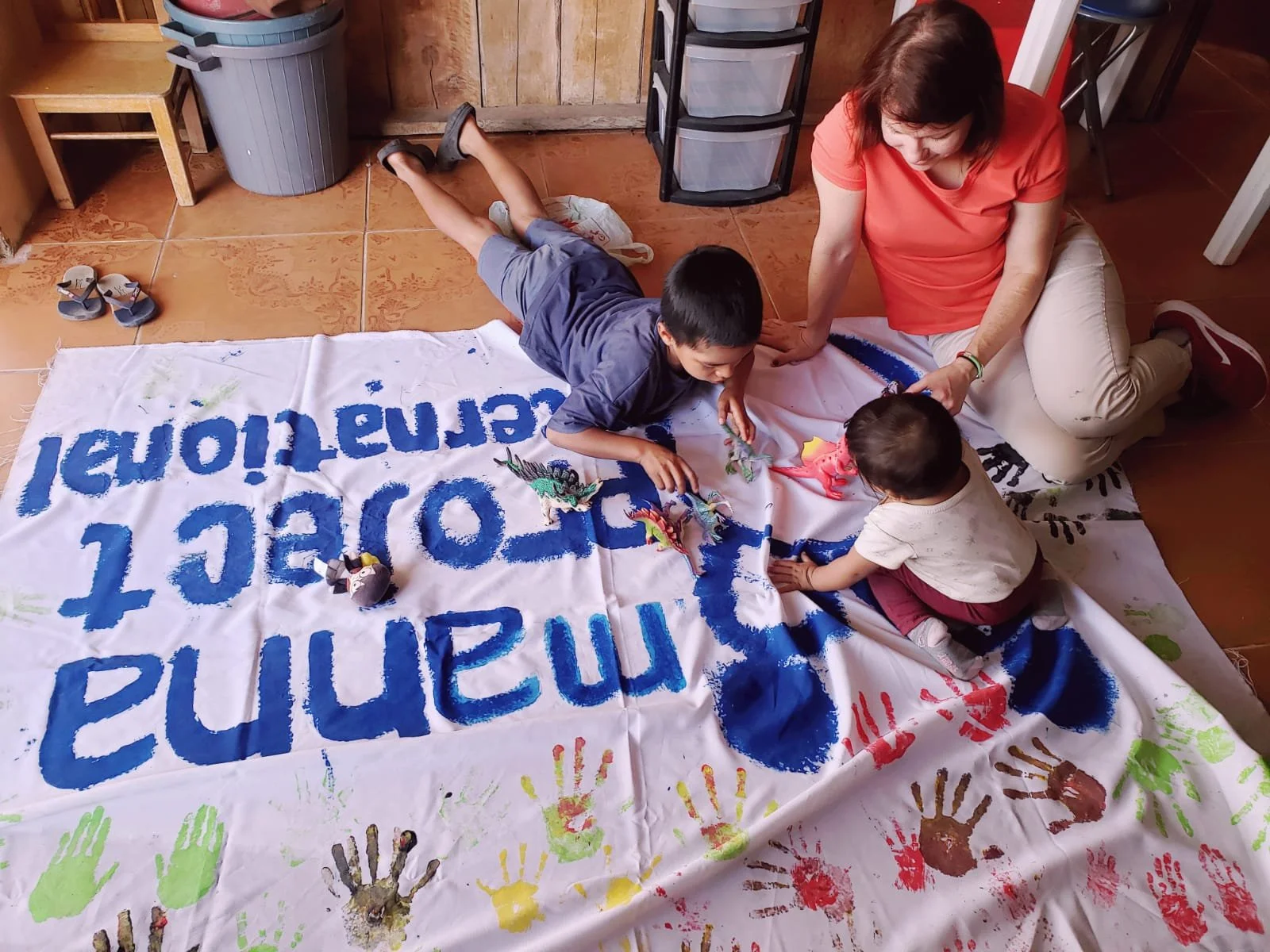Threads
Chet resting atop Pasachoa
"I have a ton of t-shirts. This may not be the most interesting revelation to our readers, but it is something that I’ve had on my mind for the past few days. Sonia and I switched rooms Wednesday to get the PD living arrangements squared away for summer. As I had to take all my current possessions from my old room into the office before finally moving into Sonia’s old room (Erik and Chet’s 'Fort' now) I had ample opportunity to look at exactly what is in my wardrobe.
I have 8 button-down long-sleeve shirts. One each is from Mark and Seth. I have 1 Rumiñahui soccer jersey that I play in on weekends. I have 4 jerseys from other teams (Ecuador, Argentina, LDU Quito, and a YMCA one that is good for hiking). I have a “kick it with Pi-Phi” tank top that I don’t believe I’ve worn since orientation. I have four undershirts and 3 collared polo shirts on top of that (again, two of those collared shirts are from Mark and Seth). All in all, I have 34 shirts here in Ecuador with me.
That is a ton of cotton (or polyester, as the case may be with some). And I have even more shirts sitting in my closet at home. Sure, some of these shirts have very different uses. I can only play soccer in my Rumiñahui jersey, because it is the team uniform. Some of the t-shirts are so ratty I don’t like to wear them outside the house. I try to wear a button down shirt when I’m teaching and wear either a collared shirt or an MPI shirt when I am in the library. But I wear my shirts more than once before washing and do laundry every 7-10 days, so I really have way more than I need.
I’ve learned a lot in my time here in Ecuador with Manna, but something I’m only now starting to pick up on is how to do more with less. Manna already does a pretty good job doing more with less. Of our three children’s English classes, only 2 have boards. But we had enough demand for children’s English that the English profes felt the need to offer a full third class. We have gone from having every PD in the library every afternoon to only having three there to allow us to run more programs and plan for more classes. I hope I can get a clearer picture of how to do more with less in my remaining 76 days. I don’t want to come back with this skill just to be thriftier; I don’t just want to mop my kitchen floor with a little less cleaning solution to save money in the long run. I’m interested in conserving resources because, from what I’ve seen, if you pass your extras along to someone else some really incredible results can spring from relatively small gifts. The art class, which has around 15 kids ages 5-10 coming to the library each week, has had to buy almost nothing because out biggest needs (construction paper and markers) are always being donated. Our English classes couldn’t function without the dry erase markers that get sent down a box or two at a time with volunteers. Some of the clothes I wear most often I got out of the adoption corner.
So thank you donors, and not just my donors, for everything you have made possible this year so far, both in the PD’s lives and the lives in the communities we work with. When I leave Ecuador at the end of July, I want to leave 21 shirts behind. I might even leave more if I can. If another PD doesn’t feel the need to augment their wardrobe from the adoption corner like I did, they will be passed along to Ecuadorians in need. But more than just thanking you for what you’ve already done, I want to encourage you to keep passing along little extras: small monetary gifts, in-kind donations, and even clothing to us (or an organization closer to home) to continue producing incredible results.
Song of the blog: 'Bigger than my body' by John Mayer- Chet"
Feels Like Home
Despite scurrying in and out of Quito, Mindo, the library, and everywhere in between with our first group of spring break volunteers, Sarah found some time to give us the run down on her homestay experience. Community homestay is a new program for us PDs; we spent three weeks in mid-July living with families in Quito, but now we're taking turns spending time with families in and around our community. This gives us a chance to brush up on our Spanish and, more importantly, expose ourselves to different cultures and extend relationships beyond the four walls of the centro.
"Sometimes I forget that I live in Ecuador. Mike once said that we live in a “little America,” (see interview below) and you know what? He has a point. We speak English in the house. We watch American movies and DVDs (albeit Ecuadorian bootleg versions). We cook what we know – mostly American (and occasionally Indian) meals. And we seem to maintain our fast-paced lifestyles in the midst of a country where la hora ecuatoriana (i.e. everything is late) dominates.
Last week I got a taste of Ecuadorian culture 24/7 while I was on my home stay – living, eating, and playing with an Ecuadorian family whose kids attend our children’s English classes. I was the guinea pig PD, as I was the first one to leave the shelter of our little America to live with community members. And I am happy to report that it was a phenomenal success!
Each evening, instead of piling into the camioneta bound for home, I jumped on a bus to Sangolquí and arrived at my new home just in time for dinner. I lived in one home with two parents and one daughter, but we were surrounded by the entire extended family. Within this small block of Sangolquí lives roughly 35 members of the same family. This means lots of cousins, lots of little kids, and lots of playing.
After dinner each night, I played made-up games with the kids (so funny how kids make up games… I miss that!) that ranged from playing “basketball,” where an arco was made by hitting a circle on the wall made with chalk, to “nombre” which involved a lot of running and throwing a ball at each other, to good old jump rope, which was probably a bad idea after eating such a huge dinner.
The weekend brought more cultural immersion, since last Saturday was Flag Day at school. From what I gathered, Flag Day is something that all students do on a selected day every year. They march with the flag, sing their National Anthem, and honor the students who are at the top of their class. One of the cousins with whom I was living happened to be at the top of his class, so he got to lead the march and stand in the front. The whole day turned into one big celebration – a big family lunch, lots of talking post-lunch, an afternoon in the park, and cake in the evening.
I left my new family on Sunday to travel back to the Manna House where a meeting and cooking responsibilities promptly greeted me at the door. It was good to be home and with my housemates whose screams and general absurdity I have come to love, but it is infinitely better to know that I have a family in Sangolquí that asks me every day in the library when I’m going to come back to visit and play games in the courtyard.
-Sarah"
Museum Adventures with Vanderbilt
We started the day with a late morning, homemade french toast, and english class lesson-planning while piled on the couches. After Dunc headed in to Quito to pick up our banos tickets for this Thursday, Alaina, Kira and I stopped by the local venta to pick up supplies for the evening's fruit salad (for some reason our cook came to the house at 8:30am to start dinner preparations and clean the bathrooms...apparently she thinks she needs to invest a lot of time to make us clean/well fed) and walk around Conocoto a little bit.
Everyone was out the door by 1, posters and glue and paintbrushes in hand in order to advertise for the upcoming teen center/library grand opening concert on our way to the Casa Barrial. After a few rough starts (not a good idea to try and paste a poster to a wall with severely chipping paint flakes), we got the hang of it, which will come in handy tomorrow during round two.
At 2 we met with the 14 students from my art class for a really special field trip to the Guayasamin art museum in downtown Quito. After piling all 25 of us (and Mafe's dog, for reasons we're still not quite sure of) into a far-too-small van, we were on our way... first to Conocoto to trade up the van size, then through the maze that is downtown Quito, and finally to the top of a far hill and the base of the museum's grounds.
The museum itself was a force of emotion. As it was my third time visiting, I expected the waves of emotions to hit me with a little less force, and yet each visit is an island unto itself, an experience encapsulated in the present and incredible unto itself. Walking through the museum with my students, who just last Thursday studied Guayasamin in class and created their own interpretations of his works, and listening to their responses to our guide's questions and their enthusiasm for what they were seeing was indescribably wonderful. And it was even sweeter to experience it with the Vanderbilt girls.

After a long bus ride back (made worse by the expulsion of all the pent-up energy the kids had kept a cap on during the museum), most of the girls headed home with Dunc, while Alaina, Kira and I (my two new fabulous cohorts!) headed up to the church for women's exercise, an hour that left us aching in the legs and wondering how Serena does it 3 times a week.
I just left the group up on the roof around a bon fire, roasting marshmallows, making smores, and dissecting their time down here thus far. Such rich conversation, challenging questions, and positive discussions we've had so far, I can't wait to see where the rest of the week goes. And (big news!) Dunc and I still love each other! We haven't fought yet! Best co-leaders ever :)
Until tomorrow,
Holly

Neither Here Nor There
Men in Botswana holds hands to display their purely platonic friendship. In Scotland, as in the rest of the UK, cars drive on the left side of the road. In Nicaragua adios ("to God," literally) means hello and goodbye. In Louisiana, the southern gentry stand by their chairs whenever a lady arrives at or departs from a table. Travelers both seasoned and novice note these sorts of cultural quirks. Sometimes they are just that – quirks. Often, they point to deeper cultural currents.
In my travels, these quirks have always been amusing, and at times thought-provoking to me. While in Nashville last week, for example, my sister would physically push me away for walking too close to her on the sidewalk; an amusing notion, and one which in more thoughtful moments could lead to a discussion of the quintessentially North American need for personal space.
This trip back to the US, which I spent at a conference in DC and in MPI's first organization-wide conference in Nashville, was the first time I have paid more heed to those quirks in myself than in my surroundings. When in an uncomfortable formal situation, I used to find myself reverting unconsciously to my training as a southern gentleman; now, however, I find myself acting more like a polite Ecuadorian country boy. When I walk into a room it feels more natural to greet evry last person – the men with a not-too-firm handshake, the women with a single fake kiss on the cheek – than to slip in quietly, shake hands with those in close proximity, and nod in recognition to those who make eye contact from across the room. When I make physical contact with someone on the metro (a grave offense in the US, apparently) my immediate reaction is to say perdoname rather than excuse me. And man, driving in the US is boring.
I am back in Quito now, interviewing an excitingly strong group of applicants for next year's E-team. And instead of coming back with open questions about the differences between Ecuador and the US, I come wondering about how I fit into both – or neither. So Mom, if I stand up at the table whenever you do, but then attempt awkwardly to kiss you on the cheek, you'll know why.














